Home | Airshows | The Hangar | Nostalgia | f4's F4s | Wattisham Chronicles | Links |
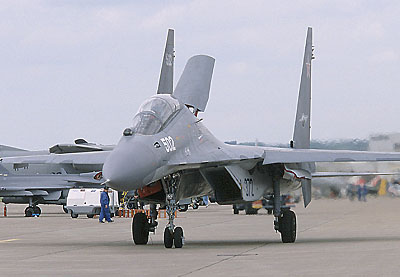 The Great Escape The Great Escape
Paris Airshow, 17-24 June Hugo Mambour/AviaScribe reflects on a mammoth event and an escape Steve McQueen would have been proud of The 44th Paris Air Show, which took place at Le Bourget airport from 17 to 24 June, was also the first one of the new century and allegedly the biggest so far. More than 1,800 representatives of aeronautical and space industries (a third of them were from the host country) from 43 different countries were present. Two hundred and forty-two aircraft were officially put on display (many aircraft were actually missing), including sixty-six of them scheduled to take part in the flying display programme. Compared to previous editions, the latter was rather monotonous with the same aircraft flying each day. A wide variety of flying machines was
present, ranging from airships to the biggest aircraft in the world. Zeppelin LZ N07,
built by Luftschifftechnik in Germany and designed to carry up to 12 passengers at 125
km/h over 900 km, flew a daily routine. More projects are being developed in Germany.
CargoLifter, which is based at Brand-Briesen (a former Soviet AF MiG-27K airbase in DDR),
is promoting giant cargo airships. The advantage of such ships is that they can transport
outsized cargo right up to the point of delivery, contrary to more traditional means of
transport, with which the cargo has to be shifted from one medium to another in order to
arrive at its destination, often in several parts. Still on the subject of outsized cargo,
the Antonov Design Bureau of Ukraine Other new civilian types included the
Airbus A340-600, equipped with new wing and tail surfaces and a stretched fuselage, and
which came off the production line in March. The ‘enemy’ of Airbus had sent the
last version and also the longest one of its 737 model, the Boeing 737-900. Relations
between Boeing and Airbus won’t go better: while Boeing recorded only three orders
during the event, Airbus benefited by no less than 371 orders, including 115 firm and 196
options for the A400M European future military transport aircraft, for which a Memorandum
of Understanding (MoU) was signed by the Defence ministers of Belgium, Luxembourg, France,
United Kingdom, Spain, Germany, and Turkey on 19 June. Italy was absent and Portugal could
not sign because its internal The Defence ministers of France, Sweden and the UK stating their joint formal commitment to the Meteor Beyond Visual Range Air to Air Missile (BVRAAM) programme, signed another MoU at Paris. Italy, Spain and Germany intend to sign once their internal approval processes are complete. Meteor is the next generation air-to-air missile chosen last year by the UK to equip the Typhoon. Eurofighter partner nations, Germany, Italy and Spain, Sweden for the Gripen and France for the Rafale, identified a similar requirement. Following the UK decision, discussions have continued with all potential partner nations, which has led to the signature of this MoU. Flight demonstrations of new generation European fighter aircraft were provided by one Gripen, the naval version of the Rafale - now operational with the recently reformed Flottille 12F at Landivisiau - and Italian Eurofighter DA7. Other Italian aircraft present at Paris included, among others, the MB339A MLU (Mid-Life Update) and the first Alenia/Lockheed Martin C-27J Spartan, which received its civil aviation certificate on 20 June. On the same day, Agusta signed a contract with the Swedish Material Administration (FMV) for the supply of twenty A109M helicopters. To be designated Hkp15, they will replace AB204, AB206 as well as H269 and will be used mainly as training platforms. However, they will also undertake other missions such as SAR, MEDEVAC or even ASW. Some helicopters will be equipped for ship-based operations.
The IAI Eagle-1 has been selected by
France to become its next real-time intelligence-gathering platform. The system could be
in service in approximately eighteen months, under the name of Heron. The French military
is considering the fitting of TV and infrared optical systems, synthetic aperture radar
and laser illuminator systems. Among more conventional military aircraft, Dassault
Aviation and Boeing both had an aircraft on static display equipped with conformal fuel
tanks (CFTs). CFTs have the advantage of causing less drag than conventional drop tanks
and leave all the hardpoints free to carry weapons or special pods. The Rafale B
demonstrator (B01) is used as the CFT development aircraft. Each tank holds 1,150 The F-16 ACE (Advanced Capabilities Enhancement) developed by a consortium led by Israeli Defence Industries and already displayed two years ago at Paris, made its first flight in May and was so successful that it received the go-ahead to be flown to France. The test pilots were impressed by the considerable improvement in performance that the newly installed display and avionics systems provide compared to the F-16's original avionics design dating back to the 1970s. Unfortunately, the Israeli Air Force does not seem interested in the upgrade and would prefer to buy a new batch of F-16I twin-seaters. Rafael had its new Derby air-to-air missile on display. This missile is outstanding in that it has both beyond visual range and within visual range capabilities. Another US aircraft, which flew daily, and seen for the first time in Paris was the F/A-18F Super Hornet. Two aircraft of VF-122, the aircrew conversion center for Super Hornet, were in France.
After Mi-8, Mi-24 and MiG-21 modernisation programmes, the Israelis have now decided to deal with the Su-25! Elbit Systems, in collaboration with Tbilisi Aerospace Manufacturing (TAM) of Georgia, have modified a Su-25BM airframe with a glass cockpit, new avionics, HOTAS and a new weapons delivery and navigation system (WDNS). The programme began in September 2000 and the resultant Su-25KM ‘Scorpion’ made its maiden flight at Tbilisi on 14 April in the hands of Elbit's chief test pilot Yehuda Shafir. The latter was also the skilful display pilot of the Su-25KM at Paris. Although this programme is currently a demonstration programme (and as such some exact equipment specifications may change) it is clearly aimed at the Georgian Air Force, which however operates only a handful of ‘Frogfoots’. TAM factory is the only facility building the original single-seat Su-25. Potential customers could either have their Su-25s upgraded or purchase new-built Scorpion airframes. Another upgrade proposed by IAI is aimed at C-130 users. The upgraded Hercules system improves flight safety and crew efficiency by reducing the pilots' workload. It uses an advanced display system and integrates the data presented to the crew, allowing them to concentrate on the operational and flight-safety tasks. The avionics system meets all Global Air Traffic Management (GATM) requirements. Eurocopter has formed a new joint venture company with Romania's IAR Brasov, creating Eurocopter Romania SA. The first contract for the company is likely to be the sale of ten new-build AS 330 Pumas to the United Arab Emirates (UAE) plus the upgrade of the UAE's existing fleet of fifteen Pumas to the same standard. One Romanian AF IAR 330 SOCAT could be seen on static display, whereas Aerostar exhibited a functional cockpit of the MiG-29 Sniper upgrade, which made its first flight on 5 May 2000.
|
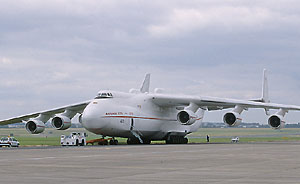 had
sent its unique
had
sent its unique 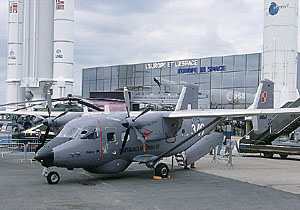 approval process was not yet finished; nevertheless,
its commitment to participate as a full member to the programme has been confirmed.
Germany's signature is subject to final approval by its parliament. The maiden flight of
the first aircraft is expected for late 2005.
approval process was not yet finished; nevertheless,
its commitment to participate as a full member to the programme has been confirmed.
Germany's signature is subject to final approval by its parliament. The maiden flight of
the first aircraft is expected for late 2005. 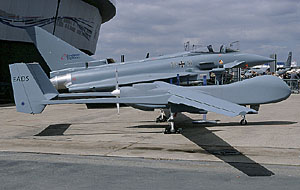 As always now in such exhibitions,
unmanned aerial vehicles were largely on show. Among the numerous UAVs, the RQ-1A
Predator, the
As always now in such exhibitions,
unmanned aerial vehicles were largely on show. Among the numerous UAVs, the RQ-1A
Predator, the 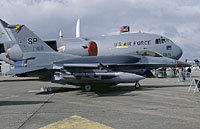
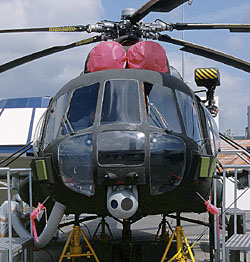 One of the most ‘exotic’
participants was an Uzbekistan AF Mi-24P. The latter, unfortunately stuck in a corner of
the static display area, was adorned with national cockades. This Hind had been modernised
by SAGEM and was equipped, among other modifications, with a sensor turret. The Israelis
did not bring their own version of the Mi-24 (nicknamed ‘Action 24’) this year.
Instead, IAI brought a modified Mi-8MTV (Mi-17) nicknamed ‘Peak 17’. The Israeli
modification, which includes a glass cockpit and an electronic warfare suite, competes
with the Russian Mi-8AMTSh. Both models are able to launch ATGM and represent a relatively
cheap alternative for the countries already equipped with Mi-17s and wishing to buy (or
modify existing airframes) multi-purpose ‘Hips’ able to conduct offensive
missions by day and night.
One of the most ‘exotic’
participants was an Uzbekistan AF Mi-24P. The latter, unfortunately stuck in a corner of
the static display area, was adorned with national cockades. This Hind had been modernised
by SAGEM and was equipped, among other modifications, with a sensor turret. The Israelis
did not bring their own version of the Mi-24 (nicknamed ‘Action 24’) this year.
Instead, IAI brought a modified Mi-8MTV (Mi-17) nicknamed ‘Peak 17’. The Israeli
modification, which includes a glass cockpit and an electronic warfare suite, competes
with the Russian Mi-8AMTSh. Both models are able to launch ATGM and represent a relatively
cheap alternative for the countries already equipped with Mi-17s and wishing to buy (or
modify existing airframes) multi-purpose ‘Hips’ able to conduct offensive
missions by day and night. 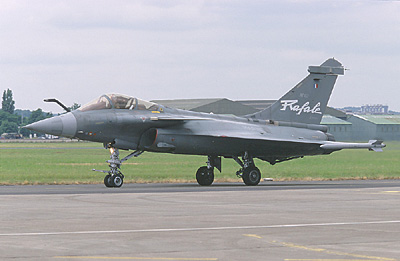 Stars of the show were once again the
Russians, but for dubious reasons! Their only fighter present was the
Stars of the show were once again the
Russians, but for dubious reasons! Their only fighter present was the